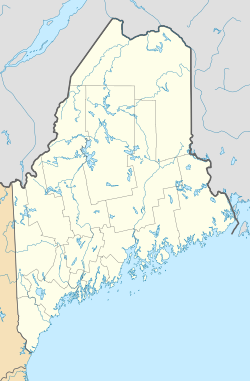Fort McClary
Fort McClary | |
 The renovated blockhouse of Fort McClary dating from 1844, which now serves as a museum | |
| Location | Off ME 103 at Fort McClary State Historic Site |
|---|---|
| Nearest city | Kittery Point, Maine |
| Coordinates | 43°04′54″N 70°42′34″W / 43.0817°N 70.7094°W |
| NRHP reference No. | 69000025 |
| Added to NRHP | October 1, 1969 |
Fort McClary is a former defensive fortification of the United States military located along the southern coast at Kittery Point, Maine at the mouth of the Piscataqua River. It was used throughout the 19th century to protect approaches to the harbor of Portsmouth, New Hampshire and the Portsmouth Naval Shipyard in Kittery. The property and its surviving structures are now owned and operated by the State of Maine as Fort McClary State Historic Site, including a blockhouse dating from 1844.
History

Colonial period
Coastal defenses on the site date to the late 17th century when shipbuilder William Pepperell (father of
The Pepperrells remained loyal to the British in 1775, so their property was confiscated by local Patriot forces, including the fort. In 1776, ammunition was provided for the fort's 9-pounder and 12-pounder cannon,[1] and the New Hampshire militia manned the fort until 1779.[2]
Second system period
Fort McClary was officially established in 1808 as part of the
Third system and Civil War
The fort was further expanded in the 1840s, probably a consequence of tensions with Great Britain over the disputed border between Maine and New Brunswick which culminated in the bloodless
The fort saw little action during the Civil War. A major rebuilding and expansion began in 1863 as part of the third system of fortifications, and the intent was to create a large five-sided fort with one or two tiers of cannon all around. However, only the seawalls were completed on the two seaward fronts, along with one of the landward cannon bastions with a granite magazine. The seawall was defended by a small caponier with rifle ports.[9] Based on war experience, masonry forts were assessed as vulnerable to rifled cannon, and funding was withdrawn from all masonry fort projects in 1867, leaving Fort McClary with few cannon positions. A large number of granite blocks remain at the fort to this day.[2]
Post Civil War to present

In the 1870s, the lower battery was rebuilt with three temporary gun positions for 10-inch
See also
- National Register of Historic Places listings in York County, Maine
- Seacoast defense in the United States
- List of coastal fortifications of the United States
References
- ^ a b c Roberts, p. 367
- ^ a b c d e f g Fort McClary at American Forts Network
- ^ "NRHP nomination for Fort McClary". National Park Service. Retrieved 2015-06-16.
- ^ a b Fort McClary at FortWiki.com
- ^ Wade, p. 139
- ^ New York Times, 8 July 1864, "Fort McClary Garrisoned, Vice-President Hamlin Among the Privates".
- ^ Maine State Guard Companies mustered in 1864
- ^ Maine State Archives, Civil War regimental correspondence
- ^ Weaver, pp. 99–101
- Roberts, Robert B. (1988). Encyclopedia of Historic Forts: The Military, Pioneer, and Trading Posts of the United States. New York: Macmillan. ISBN 0-02-926880-X.
- Wade, Arthur P. (2011). Artillerists and Engineers: The Beginnings of American Seacoast Fortifications, 1794–1815. CDSG Press. ISBN 978-0-9748167-2-2.
- Weaver II, John R. (2018). A Legacy in Brick and Stone: American Coastal Defense Forts of the Third System, 1816-1867, 2nd Ed. McLean, VA: Redoubt Press. ISBN 978-1-7323916-1-1.
External links
- Fort McClary from American Forts Network
- Maine Bureau of Parks and Land: Fort McClary State Historic Site
- Friends of Fort McClary




